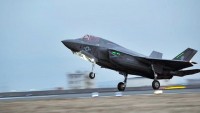US Air Force to Test 120 kW Combat Laser on AC-130J Gunship
| Arthur Dominic Villasanta | | Apr 21, 2017 09:38 PM EDT |
(Photo : USAF) AC-130J firing a laser.
The U.S. Air Force has settled on the Lockheed AC-130J Ghostrider gunship (the latest version of this historic weapon) as the test bed for its first airborne combat laser.
The first Ghostrider entered service with the U.S. Air Force Special Operations Command (AFSOC) this year. AFSOC received the first of its 32 Ghostriders in July 2015.
Like Us on Facebook
The AC-130J is a modified MC-130J Commando II with advanced features that will enable it to provide ground forces with an expeditionary, direct-fire platform that's persistent, suited for urban operations and capable of delivering precision munitions against ground targets.
One of the newest weapons the Ghostrider will test will be the Air Force's first directed energy weapon, in this case a powerful high-energy laser.
AFSOC plans to add a laser to the AC-130J by 2020. This laser will generate a 120 kW beam, an output that will later be boosted to 180 kW or 200 kW. This powerful weapon will be used to destroy anti-aircraft missiles, boats, cars, and aircraft (including aerial drones).
The laser will be mounted on the port side of the Ghostrider in place of the 30 mm autocannon.
Reports in the defense community say the laser is "rapidly moving" to practical integration with an aircraft at the MIT Lincoln Laboratory, a federally funded research and development center in Massachusetts chartered to apply advanced technology to problems of national security.
"Without the slightest bang, whoosh, thump, explosion, or even aircraft engine hum, four key targets are permanently disabled," said Lt. Gen. Brad Webb, Commander, AFSOC.
"The enemy has no communications, no escape vehicle, no electrical power and no retaliatory" intelligence, surveillance and reconnaissance capability. Minutes later, the team emerges from the compound, terrorist mastermind in hand. A successful raid."
"We're no longer talking about bulky chemical lasers, but streamlined electrical lasers," said Gen. Webb.
"These pioneering scientists have honed the ability to combine smaller lasers into a finely-tuned, exquisite single laser. Beam control seems to no longer be an issue. Nor is the cooling technology needed ... to keep the system operating."
TagsU.S. Air Force, Lockheed AC-130J Ghostrider gunship, airborne combat laser, U.S. Air Force Special Operations Command, 120 kW beam, Lt. Gen. Brad Webb
©2015 Chinatopix All rights reserved. Do not reproduce without permission
EDITOR'S PICKS
-

Did the Trump administration just announce plans for a trade war with ‘hostile’ China and Russia?
-

US Senate passes Taiwan travel bill slammed by China
-

As Yan Sihong’s family grieves, here are other Chinese students who went missing abroad. Some have never been found
-

Beijing blasts Western critics who ‘smear China’ with the term sharp power
-

China Envoy Seeks to Defuse Tensions With U.S. as a Trade War Brews
-

Singapore's Deputy PM Provides Bitcoin Vote of Confidence Amid China's Blanket Bans
-

China warns investors over risks in overseas virtual currency trading
-

Chinese government most trustworthy: survey
-

Kashima Antlers On Course For Back-To-Back Titles
MOST POPULAR
LATEST NEWS
Zhou Yongkang: China's Former Security Chief Sentenced to Life in Prison

China's former Chief of the Ministry of Public Security, Zhou Yongkang, has been given a life sentence after he was found guilty of abusing his office, bribery and deliberately ... Full Article
TRENDING STORY

China Pork Prices Expected to Stabilize As The Supplies Recover

Elephone P9000 Smartphone is now on Sale on Amazon India

There's a Big Chance Cliffhangers Won't Still Be Resolved When Grey's Anatomy Season 13 Returns

Supreme Court Ruled on Samsung vs Apple Dispute for Patent Infringement

Microsoft Surface Pro 5 Rumors and Release Date: What is the Latest?













